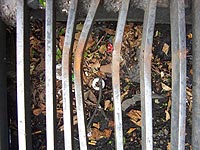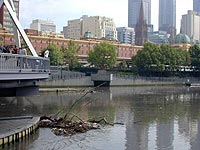You will need:
- Wet area and a bucket or two
- Large glass bowl or small fish tank (no fish)
- Plastic fish or other sea creature (optional)
- Pollutants:
- grass clippings (or garden leaves)
- soap flakes (or dish soap)
- car oil (you can use soy sauce)
- dirt (you can use cocoa powder)
- toxicants (you might choose to use glitter for heavy metals).
- One length of plastic PVC pipe
- A fish net
- Tongs
|

Some pollutants in a drain, these will
eventually enter rivers and the ocean |
|
Task 1: Create an ocean and an outfall
Hold the PVC pipe position it so that water pouring in at the top fills a large bowl or tank with clean fresh water. Observe water carefully, are there bubbles on the glass. What might this be? If you have a plastic sea creature, put it in the tank.
Gather together samples of pollutants and one by one explain what the pollutant is and tip it into the PVC pipe (still aimed at the inside of the bowl). Add more water to simulate a rain shower which washes the pollutant down. Repeat with each of the pollutants.
The result is very likely what you expected it to be. Can you still see your plastic shark. Do you think he’ll be able to live in this ocean?
Task 2: Clean it up
If your bowl is an ocean you can’t just tip it out. What can you do to clean up the polluted water?
If you have used a toy sea creature, take it out and have a look at it.
Can you draw any conclusions about keeping the stormwater clean? Do you think it is easier to keep it clean or to try to clean it up before it escapes into the receiving water? |

Debris in the Yarra River after a flood |
|
|



